Movie Review – Passion of The Christ, The
Any portrayal of the Christ story, be it His birth or death, is usually accompanied by the vocal minority standing proud to declare it heresy and sacrelidge, a Hollywood-isation of one of the greatest stories ever told. Unless told with the stifling reverence of 50’s filmmaking (a la The Greatest Story Ever Told), any portrayal of the Messiah is “fabricated” and “false” in most cases, with opinion divided on specifics of each moment of his life. Deviation from the Gospel texts is usually seen as an embellishment of established fact, something only Monty Python was ever allowed the leeway to do, and often spells the death knell for the films accuracy.
– Summary –
Director : Mel Gibson
Cast : James Caveziel, Monica Bellucci, Maia Morgenstern, Hristo Shopov, Rosalinda Celentano, Hristo Jivkov, Francesco DeVito, Claudia Gerini, Luca De Dominicis, Pietro Sarubbi.
Year Of Release : 2004
Length : 120 Minutes
Synopsis: Retelling of the last 24 hours of the life of Jesus Christ prior to, and during, His crucifixion at the hands of the Romans and Jewish leaders.
What we think : Bloody, gritty, raw film filled with either sacrilegious or sacrosanct views of Christianity and Christ Himself, depending on your beliefs. The Passion story has never felt like this before.
*******************
Poor Mel Gibson. Outrage and condemnation seems to follow him wherever he goes these days, whether it’s divorcing his wife and remarrying a much younger woman, spouting anti-Semitic abuse at traffic police or simply making films about Jesus’s death, he’s always in the spotlight. Today, though, we want to go back to a time before the public turned on him for being such a wanker, and look at one of the most controversial films of the new millennium.
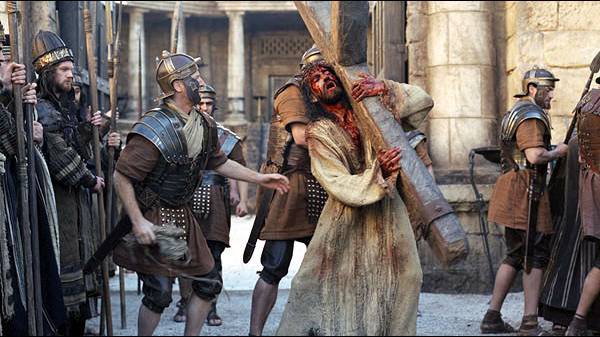
I remember when I first heard that Gibson was going to tackle a modern-day Biblical epic, the Passion story. Originally, Gibson was going to shoot it in original Aramaic and Latin, in keeping with the language of the time, and more incredibly, he would show the film with no subtitles. Gibson felt that the story was strong enough to transcend any language barrier. Considering the story is one of the founding principles of one of this planets greatest religions, I don’t think Gibson need have worried about how strong the story is! Eventually, though, Gibson relented to public pressure and conceded the inclusion of subtitles, which allows us to really get the nuances of the film.
Any portrayal of the Christ story, be it His birth or death, is usually accompanied by the vocal minority standing proud to declare it heresy and sacrilege, a Hollywood-isation of one of the greatest stories ever told. Unless told with the stifling reverence of 50’s film-making (a la The Greatest Story Ever Told), any portrayal of the Messiah is “fabricated” and “false” in most cases, with opinion divided on specifics of each moment of his life. Deviation from the Gospel texts is usually seen as an embellishment of established fact, something only Monty Python was ever allowed the leeway to do, and often spells the death knell for the films accuracy.
Taking into account the controversy surrounding this film, I’ll attempt to avoid any religious philosophy on my part, and simply review the film itself, regardless of accuracy to Biblical texts and Gibson’s supposed anti-Semitic overtones. Although, can I just say that those of Jewish faith who find this film anti-Semitic need to re-evaluate their understanding of what went on: the Jews did sell Jesus up a river and allow him to be killed. Blame for His death can be laid at their feet, and those who try and sidestep this issue by claiming a bias of antisemitism are, in this reviewers opinion, wrong. That’s my soapbox. Now, what about the film?
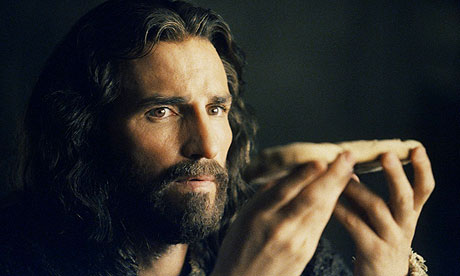
The Passion of The Christ is a “realistic” depiction of the last day of Christ’s life, from His fear of death and betrayal in the Garden of Gethsemane to His ultimate fate upon the cross. I use the term “realistic” to indicate that this isn’t some placid, clean and tidy bloodless portrayal of the Passion story, in much the same way Saving Private Ryan was a “realistic” portrayal of the landing on Normandy. The times Christ lived in were bloody, dirty and messy, a far cry from the Ben Hur style of staged action and PC violence. Gibson decided that if he was going to show Christ being beaten and crucified, he was going to do it as realistically as possible, blood and gore included. I think much of the films controversy is pointed towards this particular decision, although for better or worse, I understand why he felt the need to do so. Seeing the blood of Christ splatter across the screen as He writhes in agony against the Roman torture devices is unflinching filmmaking.
In terms of it’s dramatic structure, Passion follows fairly rigidly the Gospel texts in terms of the timeline. Those Christians who have an intimate knowledge of the Bible will be unsurprised with what transpires in the film, although they may be shocked with just how brutal it is. The pivotal moment, for many and myself included, is the sequence where Christ is taken from his cell, to a yard to be beaten, with Pontius Pilate hoping to appease the unsettled crowd that want the Jew crucified instead. Two Roman soldiers, at the command of a third, flay and scourge Christ with various implements of abuse, from a cat-o-nine-tails to hooks and barbs. It’s here, where we see the skin and blood eviscerated from the body of Christ, that we finally see how much Christ suffered for our sins. As if we didn’t need to know already. The “trial” by public opinion of Jesus by Herod in front of the angry Jewish mob, egged on by the Jewish leaders who perceived Jesus as a fraudulent Messiah and somebody who would undermine their own authority to decide Jewish laws, is powerful stuff. Pilate (Hristo Shopov), who is portrayed as pandering to the Jewish mob and questioning his own ethical feelings, is forced to sentence Jesus to crucifixion at the expense of local murderer Barabbas. The local King, Herod (the same one who decreed that all first-born children of Jewish families be murdered to prevent the arrival of Christ), in a hazy alcohol stupor, sees Jesus and decides that he is too impotent to do anything with, instead sending him to Pilate for sentencing.
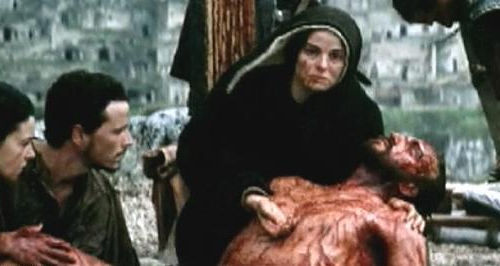
Thus begins the long walk of a brutally savaged Christ to Golgotha (also known as Calvary), a hill overlooking Jerusalem that is often used for carrying out crucifixions. He carries His own implement of death, the wooden cross upon which He we will be nailed. From what I can determine, being nailed to the cross is the ultimate in crucifixion death: the majority of those put up on crosses are simply tied there with ropes, which means that nails through the hands and feet inflict more pain and suffering. The film is violent, make no mistake, so perhaps I’d avoid using it as a Sunday School teaching aide.
Gibson fills this film with copious iconographic imagery: the blood, the cross, the androgynous Satan (Rosalinda Celentano) and the varying moments that play out in the Gospels (the betrayal by Judas, Peter’s renunciation of Jesus, the thunderous repercussions of Christ’s death). Your enjoyment of this film, which is a subjective term in itself when dealing with a film about faith anyway, will depend on your stomachs ability to handle such brutality, an assault on the eyes and ears that’s full blooded and graphic. That said, this isn’t a film you sit back and “enjoy”, as such. It’s more a film you “endure”, a story about one man’s life being given up for the sins of us all, and what you get from the film depends greatly on your faith.
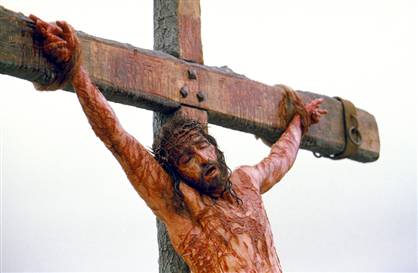
The cast are all superb in this film, particularly James Caveizel as Jesus, giving perhaps one of the truly iconic portrayals in cinema of the Lord. He imbues Christ with more humanity than any I’ve seen before, the depth of despair Caveizel reaches is heartbreaking, as he struggles with his own fear of what he’s about to do. What people must first remember is that Christ was a man, not some super-powered hero with a cape: His humanity and understanding of His mission on Earth is to save us all are all He has in the face of His own death. He may be Gods son, but that never made Him invincible and prone to our weaknesses. Caveizel gives the performance of his life as Jesus, and the film is the better for it. The other stand-out (for me) in Passion is the performance of Shopov as Pilate, the somewhat impotent Roman ruler who sentences Jesus to the cross. Shopov gives Pilate more depth and character than I’d ever considered; I always though Pilate was a cruel and nasty piece of work (perhaps showing my immaturity of Biblical understanding) and to see him portrayed as somebody essentially brow-beaten into allowing Christ to be killed (Christ had effectively broken no Roman law, and thus, Pilate was reluctant to impose this most harsh sentence upon him) is revelatory. Shopov is an excellent actor, and I was compelled with his performance. Perhaps less statured than Pilate and Christ, the weeping masses and friends of Christ who follow his trek to Golgotha, including Mary Magdalene (Monica Bellucci) and Jesus’ mother Mary (Maia Morgenstern), have limited opportunity to do anything other than cry uncontrollably.
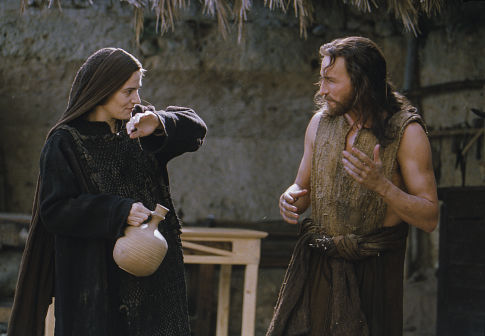
If I had to criticise any part of the film, it would be the limited time given to the disciples as characters, particularly Peter and John, although I guess liberties with them as characters can’t really dwell to far outside written scripture. The main problem with the film is that audiences have to know the characters going in: Passion isn’t an explanatory film in any sense, and those with little or no knowledge of the Christ story will be left scratching their heads. The film never really attempts to justify anything that takes place, it simply shows you what happened (in Gibson’s view) and lets you make up your own mind, for better or worse. As somebody familiar with the story, I’m more able to determine who is who on screen, when it’s not immediately clear. In much the same way filmic versions of Santa don’t dwell on that characters history every single time, most people know enough of Jesus to understand what He was about, and take that knowledge into the film.
The fact that the actors/characters all speak in dead languages (Aramaic and Latin) is of little consequence considering it’s all subtitled, although the resulting air of authenticity is undeniable. Gibson’s camera-work and editing is evocative and subtle, although his somewhat pornographic tendency to focus on the blood and gore can be off-putting. There are those who would say that this level of gore is not required to get the message of Christ’s sacrifice across; I’d disagree on the grounds that modern audiences really don’t understand what it means to be flailed to within an inch of your life, to be nailed to a cross and hung up in excruciating agony. Was Gibson justified in his delivery of Christ’s final moments and the level of their graphic impact? In terms of artistic merit, I think he was. His portrayal of the times Jesus lived in is accurate, and contextually so. That being said, I feel The Passion is, and will remain, an enduring definitive portrayal of Christ and His life, albeit a considerably short one.
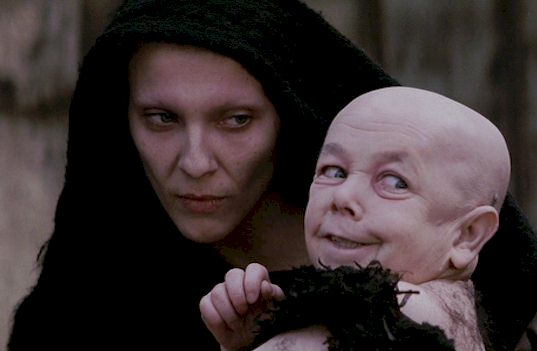
Technically, Passion looks exemplary. Cinematographer Caleb Deschanel has used a lot of muted browns, and blacks serve to highlight the blood, and contrast it against the naturalistic skin-tones on offer. From the darker, moonlit opening Garden sequence, to the cloud-swept peak of Golgotha and the film’s ultimate moment, Passion looks an absolute treat. Of particular clarity is the Jewish/Roman tone difference. Gibson gives the Romans a steely grey sheen, a metallic industrialized palette, while the Jewish tones are the predominant browns and blacks. In terms of the score, I don’t think I’ve heard one more suited to the screen imagery than John Debneys amazing work here. I first heard Debneys work on Cutthroat Island, and thought he was a perfect successor to the once-great John Williams. While Debney’s work perhaps hasn’t come in for the critical praise his musical forebear has, his score for The Passion is awe-inspiring. Subtle, melodic and ultimately uplifting, Debney’s score for The Passion represents a perfect marriage of sound and image.
The Passion Of The Christ is nothing if not divisive, at least in Christian and Jewish circles. Controversy aside, the film is an excellent work of art, although it’s sheer brutality will not endear it to many. Essential viewing for anybody in search of answers for faith, The Passion is powerful, uncompromising film-making.
*********************************************************************************************













Terrific work! Loved this film, and your review of it hits the right mark. You're spot on with your assessment!
Thanks cna, glad you approve! A terrific film (if a little hard to watch!) that Mel Gibson should rightly be proud of.